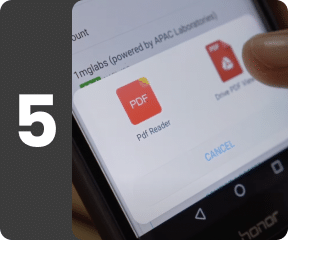Hepatitis B Virus - Viral Load, Quantitative (PCR)
Understanding Hepatitis B Virus - Viral Load, Quantitative (PCR)
What is Hepatitis B Virus - Viral Load, Quantitative (PCR)?
The Hepatitis B Virus - Viral Load, Quantitative (PCR) test measures the amount of hepatitis B virus DNA (genetic material) in the blood. This test helps monitor the progression of hepatitis B infection and assess the efficacy of an ongoing hepatitis B treatment.
Hepatitis B is a viral infection that primarily affects the liver. The infection can be acute (short and severe) or chronic (long-term). If left uninformed, it can lead to liver damage, cirrhosis, or liver cancer. However, it is preventable with a safe and effective vaccine, and early detection helps in managing the condition and reducing complications.
- Acute hepatitis B: An infection of acute hepatitis B can take as long as six months (with or without symptoms), and infected individuals can transmit the virus to others during this duration.
- Chronic hepatitis B: If the virus remains in the blood for more than six months, the infection is considered chronic. While most adults are able to clear the virus and do not develop chronic hepatitis B, infants and young children are less likely to eliminate the virus from their bodies. As a result, they are at a higher risk of developing chronic hepatitis B infection.
The Hepatitis B Virus - Viral Load, Quantitative (PCR) test is performed to assess the viral load (amount of virus in an infected person’s blood) and measure the severity of the HBV infection in an individual.
It must be kept in mind that this test is not performed to detect an HBV infection. People who are already suffering from hepatitis B infection (Chronic hepatitis B) may get this test done to get the necessary information about how serious the infection has become. Apart from that, it also helps to monitor treatment response in patients who are receiving hepatitis B treatment.
Usually, no special preparation is needed for this test. You may eat and drink as per your daily routine. Talk to your doctor about your specific test results. Tell them about your complete medical history to help them correlate your clinical and laboratory findings.
ab test results may vary across laboratories. Talk to the doctor about the specific test results. Abnormal test results require an expert interpretation. Therefore, never try to self-medicate based solely on these results. Always consult a doctor for a proper understanding of the test results.
What is Hepatitis B Virus - Viral Load, Quantitative (PCR) used for?
The Hepatitis B Virus - Viral Load, Quantitative (PCR) test is done:
- To assess disease progression and treatment efficacy in individuals with chronic hepatitis B.
- To identify individuals at higher risk of liver-related complications and initiate appropriate interventions.
- To assess the risk of transmission in pregnant women with chronic hepatitis B.
What does Hepatitis B Virus - Viral Load, Quantitative (PCR) measure?
The Hepatitis B Virus - Viral Load, Quantitative (PCR) test detects the quantity of HBV DNA (the virus's genetic material) in the blood. This is referred to as the viral load. An elevated viral load suggests that the virus is currently reproducing within the body, which can heighten the risk of liver injury and progression of disease. The test employs a very sensitive method known as quantitative polymerase chain reaction (PCR) to find and measure even minute levels of the virus. The test assists doctors in assessing the severity of the infection and the response to treatment.
Interpreting Hepatitis B Virus - Viral Load, Quantitative (PCR) results
Interpretations
|
RESULT in IU/mL |
REMARKS |
|
Target not detected |
The sample provided does not contain HBV DNA |
|
<20 |
HBV DNA detected, but below the lower limit of the linear range of the assay. These results should be interpreted with caution |
|
>=20 to < 1.7 x 108 |
HBV DNA detected within the linear range of the assay |
|
>=1.7 x 108 |
HBV DNA detected above the linear range of the assay |
-
The linear reporting range of the assay is 20 - 1.7 x 108 IU/mL
-
Conversion factor: 1 IU/mL = 5.82 copies / mL
Results are categorized into 3 levels
-
Low or undetectable viral load means that the lab equipment cannot detect it, and viral load is less than approximately 300 copies/mL
-
Moderate levels are about 10,000 – 90,000 copies/mL
-
High levels indicate quantities over 100,000 copies/mL, which is considered clinically significant
Frequently Asked Questions about Hepatitis B Virus - Viral Load, Quantitative (PCR)
Q. What is the full form of HBV?
Q. Why do I need the Hepatitis B Virus - Viral Load, Quantitative (PCR) test during the treatment of HBV infection?
Q. Why is measuring viral load important in the case of pregnancy?
Q. Is it safe for a pregnant woman with hepatitis B to breastfeed her baby?
Q. Can the Hepatitis B Virus - Viral Load, Quantitative (PCR) test be used to diagnose hepatitis B infection?
Q. What does it mean if the viral load is undetectable?
Q. What are the symptoms of hepatitis B infection?
Q. How long does it take for the symptoms to show up after getting infected with a hepatitis B virus?
Q. How is hepatitis B transmitted?
Q. Can hepatitis B spread through food or water?
Q. How long is hepatitis B infectious?
Q. How can I prevent hepatitis B infection?
Q. What are the types of hepatitis viruses?
Book a Hepatitis B Virus - Viral Load, Quantitative (PCR) test at home near me





Other tests









